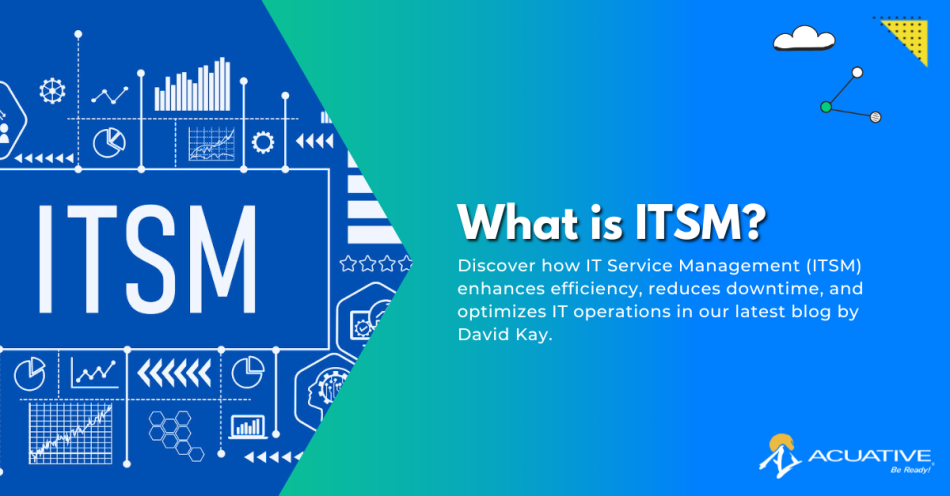Behind every glitch-free Zoom call and lightning-fast software update is a hidden force called ITSM. IT Service Management (ITSM) is far more than a technical term – it’s the disciplined framework that ensures your organization’s IT operations run with precision and efficiency. Acting as the strategic backbone, ITSM orchestrates the seamless integration of applications, safeguards critical data, and empowers IT teams to deliver consistent, high-quality support. Let’s explore this process and reveal how it transforms IT challenges into opportunities for innovation and growth.
Contents:
- Defining ITSM
- The Role of ITSM Frameworks
- Key Components of ITSM
- Why ITSM Matters
- ITSM in Action
- Looking Ahead with Acuative
Defining ITSM
ITSM, or IT Service Management, is a set of processes, practices, and tools designed to deliver and manage IT services effectively. Rather than focusing solely on technology, ITSM emphasizes processes, best practices, and continuous improvement to ensure IT services contribute to overall business success. It encompasses everything from incident resolution and change management to service delivery and customer support. By implementing ITSM practices, organizations can enhance efficiency, reduce downtime, and provide a better experience for both end users and IT teams. Ultimately, ITSM is about delivering value—whether that means ensuring seamless digital experiences for customers or empowering employees with reliable technology solutions.

The Role of ITSM Frameworks
ITSM is not just an abstract concept—it is often implemented through structured frameworks that provide guidelines for optimizing IT service delivery. One of the most widely adopted frameworks is ITIL (Information Technology Infrastructure Library), which outlines best practices for managing IT services across their entire lifecycle. ITIL helps organizations improve efficiency, streamline workflows, and standardize processes, covering everything from incident and problem management to service desk operations and change control.
In addition to ITIL, other frameworks also play a role in shaping ITSM strategies. COBIT (Control Objectives for Information and Related Technologies) focuses on governance and ensuring IT aligns with business objectives, while ISO/IEC 20000 is an international standard for IT service management that emphasizes continuous improvement and compliance. Depending on an organization’s size, industry, and regulatory requirements, different frameworks may be adopted or combined to create a tailored ITSM approach. By leveraging these frameworks, businesses can establish more consistent, effective, and scalable IT operations that support long-term growth and stability.
Key Components of ITSM
So, what does ITSM actually involve? Here are some of its core elements:
- Service Desk: The central point of contact for IT support, resolving issues quickly to minimize downtime.
- Incident Management: Handling unexpected disruptions (think system outages) to restore normal service as fast as possible.
- Change Management: Managing updates or modifications to IT systems in a controlled way to avoid unintended consequences.
- Asset Management: Keeping track of IT resources, from hardware to software licenses.
- Problem Management: Identifying and addressing the root causes of recurring issues to prevent future disruptions.
Why ITSM Matters
For businesses, transformative approach that enhances the efficiency and effectiveness of IT operations. By implementing ITSM best practices, companies can establish a structured framework for managing IT services, ensuring that technology aligns seamlessly with business objectives. This not only helps organizations maintain stability and reliability in their IT environments but also drives innovation and continuous improvement. By adopting ITSM, organizations can:
- Enhance customer satisfaction through reliable services.
- Boost efficiency by automating repetitive tasks.
- Mitigate risks with proactive problem-solving.
- Stay competitive in an ever-evolving digital landscape.
ITSM in Action
ITSM shines across industries, delivering real-world results. Here’s how it makes a difference:
- Retail: Picture a retail chain launching a new online ordering system during a holiday rush. A glitch threatens hours of downtime and lost sales. With ITSM, the IT team logs the issue, prioritizes it, and deploys a fix—keeping customers shopping seamlessly.
- Healthcare: In a hospital, a network failure could delay access to patient records, risking lives. ITSM ensures rapid incident response and proactive monitoring, so clinicians stay connected to critical systems 24/7.
- Government: A government agency rolling out a citizen portal can’t afford security breaches or outages. ITSM’s change management and asset tracking keep updates secure and infrastructure reliable, serving the public without interruption.
- Banking: For a bank, a downed payment system means frustrated customers and regulatory headaches. ITSM’s problem management digs into root causes, preventing repeat issues and ensuring transactions flow smoothly.
In each case, ITSM turns potential chaos into controlled, efficient outcomes—proving its value across sectors.
Looking Ahead with Acuative
The future of ITSM is brighter than ever, and Acuative is at the forefront of innovation. Our IT Service Management Tool Services provide comprehensive evaluation and expert guidance to help businesses select, implement, and optimize their ITSM toolsets. By leveraging industry frameworks, best practices, and our proprietary methodology, we work closely with stakeholders to design tailored solutions that enhance service quality and reduce costs. Whether you need a strategic ITSM roadmap, seamless tool integration, or ongoing process improvement, Acuative ensures your IT operations are efficient, agile, and ready for the future.
Dive deeper into how Acuative delivers world-class ITSM solutions in our IT Service Management Factsheet.
About David Kay
 David Kay is a seasoned Enterprise Sales Director with 25+ years of experience in telecom, IT infrastructure, and SaaS. Leading GTM sales at Acuative—a Cisco Gold Partner and global Elite Elastic Partner—he specializes in managed networks, 5G, SD-WAN, and security solutions. With past leadership roles at T-Mobile, QA North America, RED Trucking, and Sprint, David has built high-performing teams and driven multimillion-dollar growth. Skilled in Cisco Networking, Enterprise Architecture, 5G, MEDDIC methodology, and strategic relationship-building, he thrives at discussing how technology can help stimulate business growth.
David Kay is a seasoned Enterprise Sales Director with 25+ years of experience in telecom, IT infrastructure, and SaaS. Leading GTM sales at Acuative—a Cisco Gold Partner and global Elite Elastic Partner—he specializes in managed networks, 5G, SD-WAN, and security solutions. With past leadership roles at T-Mobile, QA North America, RED Trucking, and Sprint, David has built high-performing teams and driven multimillion-dollar growth. Skilled in Cisco Networking, Enterprise Architecture, 5G, MEDDIC methodology, and strategic relationship-building, he thrives at discussing how technology can help stimulate business growth.
Connect with David here to explore how he can help your organization Be Ready!

